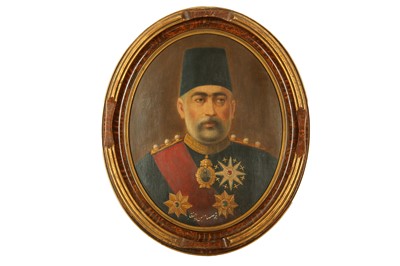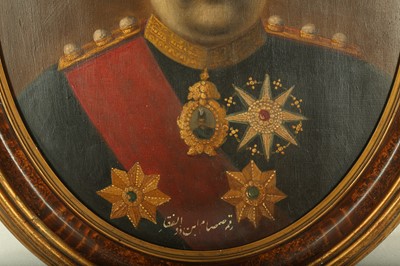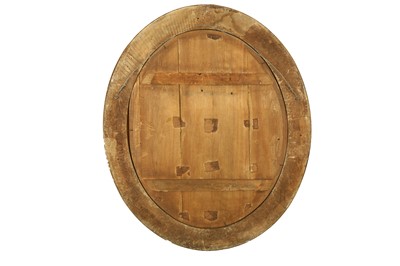16th Apr, 2021 13:00
Islamic & Indian Art
AN OVAL PORTRAIT OF MIRZA 'ALI ASGHAR KHAN AMIN AL-SOLTAN (1858 - 1907)
Qajar Iran, late 19th century - early 20th century, signed by Samsam Ibn Zulfaqar
AN OVAL PORTRAIT OF MIRZA 'ALI ASGHAR KHAN AMIN AL-SOLTAN (1858 - 1907)
PROPERTY FROM A PRIVATE UK COLLECTION
Qajar Iran, late 19th century - early 20th century, signed by Samsam Ibn Zulfaqar
Oil on wooden board, the oval bust portrait depicting the last Prime Minister of Iran under Nasir al-Din Shah Qajar, Mirza 'Ali Asghar Khan, also known as Amin al-Soltan and Atabak, dressed in formal military attire with a red sash on his right shoulder and several military decorations on his chest, including the Imperial Portrait medal (homayoun or temssaal-e homayouni) intended for high-ranking officials and foreign dignitaries consisting in an oval medallion usually 12-14 cm long with the portrait of the Shah, encased within a frame encrusted with diamonds and bearing a crown at the top, signed in white at the bottom by the late Qajar painter Samsam Ibn Zulfaqar, set within a later oval briar wood frame, 49cm x 39cm excluding the frame.
Mirza 'Ali Asghar had an impressive political career, which culminated with his appointment as Prime Minister under Nasir al-Din Shah Qajar in 1887 (A. Amanat, AMĪN-AL-SOLṬĀN, ĀQĀ EBRĀHĪM. in Encyclopedia Iranica, 1989, pp. 949–951). After the Shah's assassination in 1896, 'Ali Asghar worked really hard to maintain the stability of the country and to secure a smooth transition to the next ruler, Muzaffar al-Din Shah Qajar, the Shah's son. After being dismissed from office shortly after the new Shah's settlement, 'Ali Asghar was then called back in the middle of the Iranian Constitutional Revolution. His latest office lasted only a couple of months as he was assassinated in front of the Parliament on 31st August 1907.
The choice of subject for this portrait is quite distinctive. Samsam Ibn Zulfaqar is renowned as one of the main masters of the last Qajar school of royal portraiture, but at the time he was active the reputation of 'Ali Asghar was undergoing important peaks and troughs (G. Fellinger in L'Empire des Roses: Chefs-d'oeuvre de l'art persan du XIXe siecle, Louvre-Lens, 2018, pp. 294 - 297). Following Nasir's assassination in 1896, the wheel of fortune turned for the Prime Minister, and 'Ali Asghar was kept in and out of office, according to the last Qajar rulers' whims. In this portrait, he is depicted as a military man, wearing the typical black Astrakhan fur kaj kolah, proudly showing off his military decorations. His expression appears to be quite nostalgic, a common trait of many late Qajar oils.
Perhaps one of the most curious elements in the portrait is the red sash crossing the Prime Minister's chest. Indeed, according to Qajar military ceremonial standards, the commander-in-chief of the armed forces (sardar sepah) was to wear a blue sash bordered with green stripes; three-star generals wore instead a red sash with green border stripes; and two-star generals a red sash with white border stripes. Only simple brigadier-generals wore plain red. For a man that has achieved so much and received many military decorations, the presence of a plain red sash could suggest either a post-mortem private commission, inspired by the memory of the patron rather than a precise picture or photograph, or the painter's subjective and distinctive choice of portraying a nostalgic and melancholic 'Ali Asghar reminiscing about his younger days in the military.
Sold for £1,750
Includes Buyer's Premium
Do you have an item similar to the item above? If so please click the link below to submit a free online valuation request through our website.




